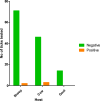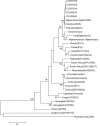Molecular Assay on Crimean Congo Hemorrhagic Fever Virus in Ticks (Ixodidae) Collected from Kermanshah Province, Western Iran
- PMID: 27308296
- PMCID: PMC4906744
Molecular Assay on Crimean Congo Hemorrhagic Fever Virus in Ticks (Ixodidae) Collected from Kermanshah Province, Western Iran
Abstract
Background: Crimean-Congo Hemorrhagic Fever (CCHF) is a feverous and hemorrhagic disease endemic in some parts of Iran and caused by an arbovirus related to Bunyaviridae family and Nairovirusgenus. The main virus reservoir in the nature is ticks, however small vertebrates and a wide range of domestic and wild animals are regarded as reservoir hosts. This study was conducted to determine the infection rate of CCHF virus in hard ticks of Sarpole-Zahab County, Kermanshah province, west of Iran.
Methods: From total number of 851 collected ticks from 8 villages, 131 ticks were selected randomlyand investigated for detection of CCHF virus using RT-PCR.
Results: The virus was found in 3.8% of the tested ticks. Hyalommaanatolicum, H. asiaticum and Rhipicephalus sanguineus species were found to have viral infection, with the highest infection rate (11.11%) in Rh. sanguineus.
Conclusion: These findings provide epidemiological evidence for planning control strategies of the disease in the study area.
Keywords: CCHFV; Iran; Ixodidae; Kermanshah.
Figures




Similar articles
-
Hard ticks (Ixodidae) and Crimean-Congo hemorrhagic fever virus in south west of Iran.Acta Med Iran. 2015;53(3):177-81. Acta Med Iran. 2015. PMID: 25796025
-
First phylogenetic analysis of a Crimean-Congo hemorrhagic fever virus genome in naturally infected Rhipicephalus appendiculatus ticks (Acari: Ixodidae).Arch Virol. 2015 May;160(5):1197-209. doi: 10.1007/s00705-015-2379-1. Epub 2015 Mar 6. Arch Virol. 2015. PMID: 25742932
-
Molecular detection of Crimean-Congo Haemorrhagic Fever (CCHF) virus in hard ticks from South Khorasan, east of Iran.J Vector Borne Dis. 2022 Jul-Sep;59(3):241-245. doi: 10.4103/0972-9062.342400. J Vector Borne Dis. 2022. PMID: 36511040
-
Vectors of Crimean Congo Hemorrhagic Fever Virus in Iran.J Arthropod Borne Dis. 2015 Mar 11;9(2):137-47. eCollection 2015 Dec. J Arthropod Borne Dis. 2015. PMID: 26623426 Free PMC article. Review.
-
Crimean-Congo hemorrhagic fever.Antiviral Res. 2004 Dec;64(3):145-60. doi: 10.1016/j.antiviral.2004.08.001. Antiviral Res. 2004. PMID: 15550268 Review.
Cited by
-
Crimean-Congo Hemorrhagic Fever Virus in Asia, Africa and Europe.Microorganisms. 2021 Sep 9;9(9):1907. doi: 10.3390/microorganisms9091907. Microorganisms. 2021. PMID: 34576803 Free PMC article. Review.
-
Risk factors associated with exposure to Crimean-Congo haemorrhagic fever virus in animal workers and cattle, and molecular detection in ticks, South Africa.PLoS Negl Trop Dis. 2021 May 28;15(5):e0009384. doi: 10.1371/journal.pntd.0009384. eCollection 2021 May. PLoS Negl Trop Dis. 2021. PMID: 34048430 Free PMC article.
-
Crimean-Congo hemorrhagic fever cases in the North of Iran have three distinct origins.Virusdisease. 2017 Mar;28(1):50-53. doi: 10.1007/s13337-016-0359-z. Epub 2017 Jan 19. Virusdisease. 2017. PMID: 28466055 Free PMC article.
-
Detailed new insights about tick infestations in domestic ruminant groups: a global systematic review and meta-analysis.J Parasit Dis. 2022 Jun;46(2):526-601. doi: 10.1007/s12639-021-01460-4. Epub 2022 Jan 16. J Parasit Dis. 2022. PMID: 35692485 Free PMC article. Review.
-
Crimean-Congo haemorrhagic fever virus in ticks, domestic, and wild animals.Front Vet Sci. 2025 Jan 16;11:1513123. doi: 10.3389/fvets.2024.1513123. eCollection 2024. Front Vet Sci. 2025. PMID: 39897158 Free PMC article. Review.
References
-
- Champour M, Chinikar S, Mohammadi G, Razmi G, Shah-Hosseini N, Khakifirouz S, Mostafavi E, Jalali T. ( 2016) Molecular epidemiology of Crimean-Congo hemorrhagic fever virus detected from ticks of one humped camels (Camelus dromedarius) population in northeastern Iran. J Parasit Dis. 40( 1): 110– 5. - PMC - PubMed
-
- Charrel R, Attoui H, Butenko A, Clegg J, Deubel V, Frolova T, Gould E, Gritsun T, Heinz F, Labuda M. ( 2004) Tick-borne virus diseases of human interest in Europe. Clin Microbiol Infect. 10( 12): 1040– 1055. - PubMed
-
- Chinikar S, Persson SM, Johansson M, Bladh L, Goya M, Houshmand B, Mirazimi A, Plyusnin A, Lundkvist A, Nilsson M. ( 2004) Genetic analysis of Crimean-Congo Hemorrhagic Fever virus in Iran. J Med Virol. 73( 3): 404– 411. - PubMed
-
- Chinikar S, Shayesteh M, Khakifirouz S, Jalali T, Rasi-Varaie FS, Rafigh M, Mostafavi E, Shah-Hosseini N. ( 2013) Nosocomial infection of Crimean–Congo Hemorrhagic fever in eastern Iran: case report. Travel Med Infect Dis. 11( 4): 252– 255. - PubMed
LinkOut - more resources
Full Text Sources
